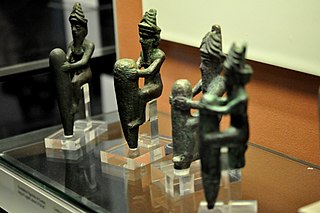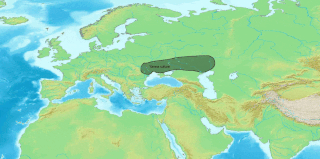| Rundas | |
|---|---|
God of the hunt |
Rundas is the Hittite god of the hunt and of good fortune. His emblem is a double eagle with a hare in each talon. [1]

Kültepe, also known as Kanesh or Nesha, is an archaeological site in Kayseri Province, Turkey, inhabited from the beginning of the 3rd millennium BC, in the Early Bronze Age. The nearest modern city to Kültepe is Kayseri, about 20km southwest. It consisted of an Upper city, and a lower city, where an Assyrian kārum, trading colony, was found. Its ancient names are recorded in Assyrian and Hittite sources. In cuneiform inscriptions from the 20th and the 19th century BC, the city was mentioned as Kaneš (Kanesh); in later Hittite inscriptions, the city was mentioned as Neša, or occasionally as Aniša (Anisha). In 2014, the archaeological site was inscribed in the Tentative list of World Heritage Sites in Turkey. It is the place where the earliest record of a definitively Indo-European language has been found, Hittite, dated to the 20th century BC.

In Greek mythology, Eteocles was a king of Thebes, the son of Oedipus and either Jocasta or Euryganeia. Oedipus killed his father Laius and married his mother without knowing his relationship to either. When the relationship was revealed, he was expelled from Thebes. The rule passed to his sons Eteocles and Polynices. However, because of a curse from their father, the two brothers did not share the rule peacefully and died as a result, ultimately killing each other in battle for control of the city. Upon his death, Eteocles was succeeded by his uncle, Creon.

The Anunnaki are a group of deities of the ancient Sumerians, Akkadians, Assyrians and Babylonians. In the earliest Sumerian writings about them, which come from the Post-Akkadian period, the Anunnaki are deities in the pantheon, descendants of An and Ki, the god of the heavens and the goddess of earth, and their primary function was to decree the fates of humanity. They should not be confused with the Apkallu.

The Hattians were an ancient Bronze Age people that inhabited the land of Hatti, in central Anatolia. They spoke a distinctive Hattian language, which was neither Semitic nor Indo-European. Hattians are attested by archeological records from the Early Bronze Age and by historical references in later Hittite and other sources. Their main centre was the city of Hattush. Faced with Hittite expansion, Hattians were gradually absorbed into the new political and social order, imposed by the Hittites, who were one of the Indo-European-speaking Anatolian peoples. The Hittites kept the country name unchanged, which also became the main designation for the Hittite state.

Arinna was the major cult center of the Hittite sun-goddess known as dUTU URUArinna or "Sun-Goddess of Arinna", who is also sometimes identified as Arinniti or as Wuru(n)šemu. Arinna was located near Hattusa, the Hittite capital.

In Hittite mythology, Illuyanka was a serpentine dragon slain by Tarḫunz, the Hittite incarnation of the Hurrian god of sky and storm. It is known from Hittite cuneiform tablets found at Çorum-Boğazköy, the former Hittite capital Hattusa. The contest is a ritual of the Hattian spring festival of Puruli.
Hasameli was the Hittite god of metalworkers and craftsmen. Associated with smoke, he is called on by Mursili II in his Annals to encircle and cloak him that he be concealed from his enemy in a covert assault. He may be related with the Greek Hephaestus.
In Hittite mythology, Ḫalmašuit was the "throne-goddess" of the kings. The Hittites believed that the kings derived their right to rule from Ḫalmašuit.

Armenian mythology originated in ancient Indo-European traditions, specifically Proto-Armenian, and gradually incorporated Hurro-Urartian, Mesopotamian, Iranian, and Greek beliefs and deities.
Ḫannaḫanna was a Hittite mother goddess.
Inara, in Hittite mythology, was the goddess of the wild animals of the steppe and daughter of the Storm-god Teshub/Tarhunt. She corresponds to the "potnia theron" of Greek mythology, better known as Artemis.

The Anatolians were Indo-European-speaking peoples of the Anatolian Peninsula in present-day Turkey, identified by their use of the Anatolian languages. These peoples were among the oldest Indo-European ethnolinguistic groups and one of the most archaic, because Anatolians were among the first Indo-European peoples to separate from the Proto-Indo-European community that gave origin to the individual Indo-European peoples.

Hittite mythology and Hittite religion were the religious beliefs and practices of the Hittites, who created an empire centered in what is now Turkey from c. 1600–1180 BC.
Salatiwara was a Middle Bronze Age city in south-central Anatolia on a road connecting the kingdoms Waḫšušana and Burushattum. The history of the city is known primarily from the Anitta text.

Zalpuwa, traditionally also thought to be Zalpa, was a still-undiscovered Bronze Age city in Anatolia of around the 18th century BC. Its history is largely known from the Proclamation of Anitta, CTH 1. It has now been proposed that the Zalpa mentioned in the Annals of Hattusili I, CTH 4, was a different city located at Tilmen Höyük, in the Karasu River Valley south of the Taurus Mountains by Tubingen and Chicago Universities recent excavations.
In Hurrian mythology, Ullikummi is a giant stone monster, son of Kumarbi and the sea god's daughter, Sertapsuruhi, or a female cliff. The language of the literary myth in its existing redaction is Hittite, in cuneiform texts recovered at Bogaskoy, where some Hurrian fragments of the "Song of Ullikummi" have been found. See Guterbock (1951).
Telipinu was a Hittite god who most likely served as a patron of farming, though he has also been suggested to have been a storm god or an embodiment of crops. He was a son of the weather god Tarḫunna (Taru) and the solar goddess Arinniti in the system of their mythology. His wife was the goddess Ḫatepuna, though he was also paired with Šepuru and Kataḫḫa at various cultic centres.

Pala (cuneiform pa-la-a was a Bronze Age country in Northern Anatolia. Little is known of Pala except its native Palaic language and its native religion. Their language shared common innovations with Luwian not present in the Hittite language suggesting a prior Luwian-Palaic linguistic complex.